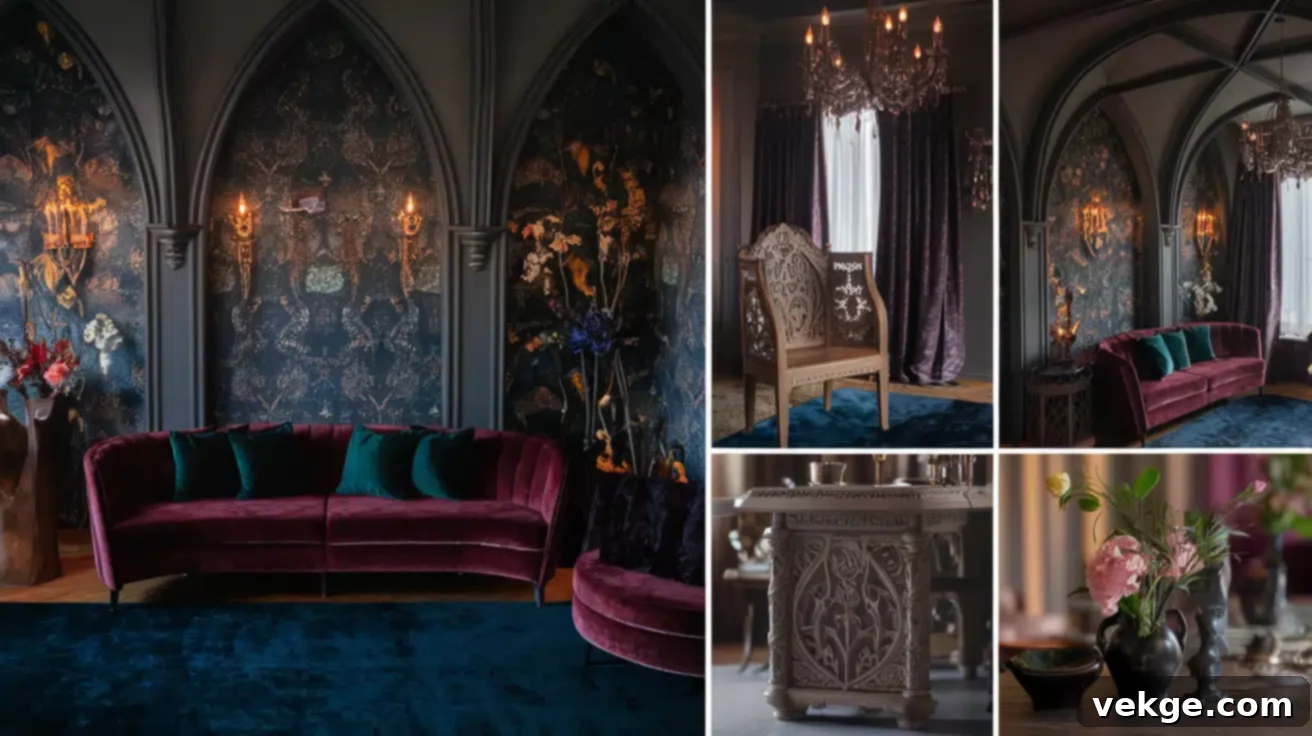Mastering Gothic Interior Design: Your Complete Guide to Timeless Elegance and Dramatic Home Decor
Are you captivated by the allure of dramatic, historical aesthetics and seeking to infuse your living space with a touch of grandeur? If so, you’re in the perfect place. Welcome to our definitive guide on Gothic interior design, where we unveil the secrets to transforming your home into an enchanting sanctuary that resonates with medieval mystique and modern sophistication.
This extensive guide delves into the essence of bringing a rich, medieval-inspired style into contemporary homes. We’ll explore the strategic use of deep, resonant colors, distinctive designer features, and sumptuous textures that define the Gothic aesthetic. Our journey will take you through various room-by-room applications, from crafting a captivatingly moody living room to designing a truly dramatic dining space, all while demonstrating how to impeccably balance historical elements with the practical needs of today’s lifestyle.
Whether you’re fortunate enough to work with authentic Gothic architecture or simply wish to add subtle Gothic touches to a standard home, you’ll find an abundance of practical advice and inspirational ideas within these pages. Our aim is to empower you to create spaces that honor the profound beauty of this enduring style, ensuring they remain supremely comfortable and functional for modern living. Prepare to embark on a design adventure that will leave your home imbued with unparalleled character and a timeless appeal.
What is Gothic Interior Design? Unveiling the Medieval Aesthetic for Modern Homes
Gothic interior design is far more than just a style; it’s an immersive experience that transports the rich, dramatic essence of medieval-inspired architecture and artistry into the heart of modern homes. This distinctive approach to interior decorating is characterized by its powerful visual statements, often featuring elements such as soaring pointed arches, intricately carved woodwork, and striking contrasts that collectively forge atmospheric and deeply evocative spaces.
At its core, Gothic interior design embraces a profound sense of drama and opulence. Key elements that define this style include a carefully curated palette of deep, saturated colors like regal burgundy, mystical forest green, and profound navy blue. These dark hues are frequently balanced with lustrous metallic accents in gold or silver, which catch the light and add an essential layer of luxury and refinement. The interplay between these dark foundations and shimmering highlights creates a dynamic visual tension.
Luxurious textures play an equally pivotal role in establishing the authentic Gothic feel. Imagine the tactile richness of velvet upholstery adorning seating, the elegant drape of heavy, elaborate draperies at windows, and the exquisite detail of hand-carved furniture and architectural elements, all contributing to an overwhelming sense of grandeur and richness. Statement lighting is also crucial, with majestic chandeliers and ornate wall sconces casting a soft, moody ambiance that is instantly recognizable as a hallmark of Gothic design.
Ultimately, the most successful Gothic interiors master the art of balance. They expertly weave historical drama with modern comfort, thoughtfully incorporating traditional elements to evoke a sense of heritage without succumbing to the stiffness of a museum-like display. The result is a home that feels deeply historical, yet utterly inviting and functional for contemporary life, blending the grandeur of the past with the conveniences of the present.
Key Characteristics of Gothic Interior Design: Elements of Enduring Style
To truly grasp and implement Gothic interior design effectively, understanding its foundational characteristics is essential. These elements work in harmony to create the unique, captivating atmosphere synonymous with the style.
Moody Color Palette: The Foundation of Gothic Allure
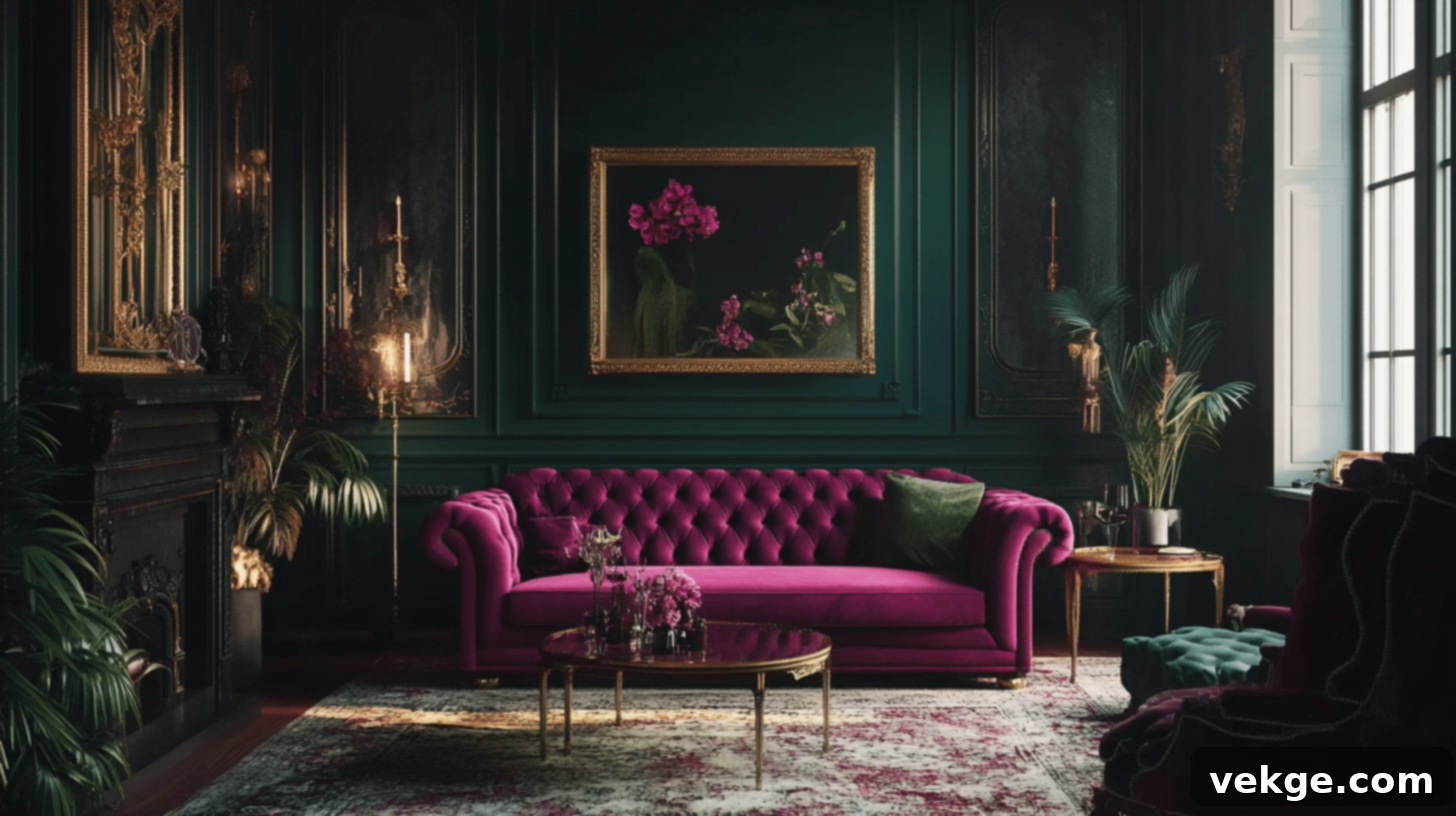
The Gothic design philosophy embraces deep, rich, and often dark colors as its fundamental building blocks. Hues like burgundy, reminiscent of ancient wines and royal robes; forest green, echoing deep, untouched woodlands; midnight blue, evoking twilight and mystery; and plum, a color of deep luxury and introspection, serve as the dramatic backdrop for everyday living. These saturated tones create an immediate sense of depth, solemnity, and comfort, enveloping a room in an almost protective embrace.
To prevent these intense colors from overwhelming a space, accent colors are strategically employed to inject necessary brightness and opulence. Gold and silver metallics provide shimmering highlights, reflecting light and adding a touch of regal splendor. Jewel tones such as vibrant emerald, passionate ruby, and serene sapphire are often introduced through textiles, artwork, or decorative objects, adding pops of vibrant color that prevent the palette from becoming monolithic. The deliberate contrast between these dark, foundational backgrounds and bright, luxurious accents creates compelling visual interest, drawing the eye to special pieces and architectural details, and ensuring the room feels dynamic rather than somber. This sophisticated color strategy is pivotal in constructing rooms that feel simultaneously historic, deeply dramatic, and profoundly welcoming.
Distinctive Gothic Motifs: Echoes of Medieval Craftsmanship
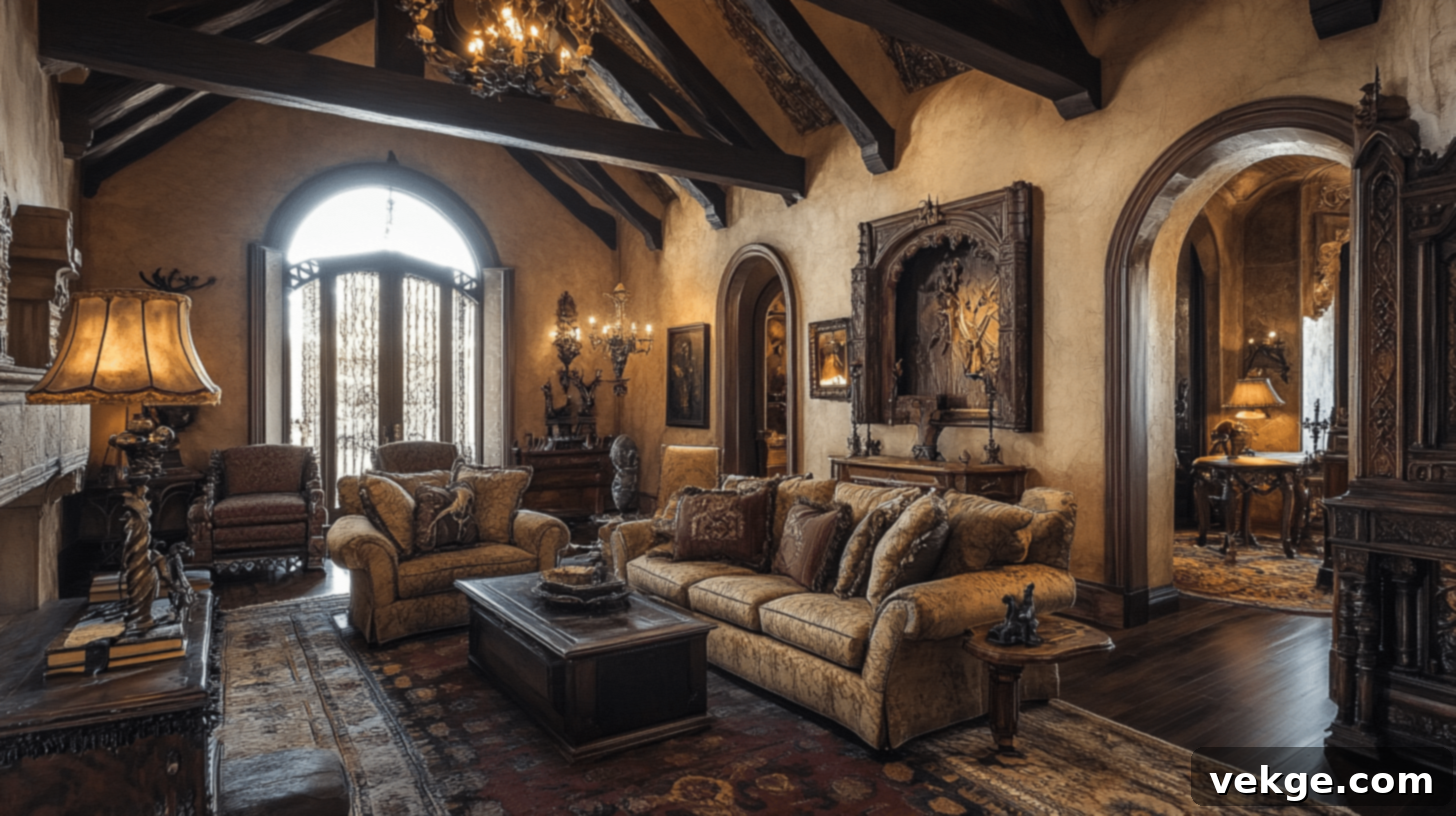
The defining architectural and decorative elements of the medieval era are what truly distinguish Gothic interiors. These motifs, often intricate and symbolic, immediately establish the Gothic character within any space. Pointed arches are perhaps the most iconic feature, appearing not only in structural elements like doorways and windows but also subtly incorporated into furniture details, mirrors, and even wallpaper patterns, instantly conveying a sense of verticality and aspiration.
Intricate woodwork is another hallmark, showcased on magnificent ceiling beams, detailed wall panels, and bespoke cabinetry. This historical craftsmanship often features complex tracery, quatrefoil designs, and deeply carved patterns that tell stories and add layers of visual texture. Furthermore, grotesque features and mythical creatures — such as stylized gargoyles, majestic dragons, proud griffins, and noble lions — serve as unique decorative objects and fascinating conversation pieces. These are often rendered in stone, wood, or metal and can be found on fireplace mantels, corbels, or even as decorative hardware. By incorporating these traditional elements, a modern home gains an authentic medieval personality, forging a powerful connection to a rich and storied design history.
Luxurious Textures: Engaging the Senses in Gothic Spaces
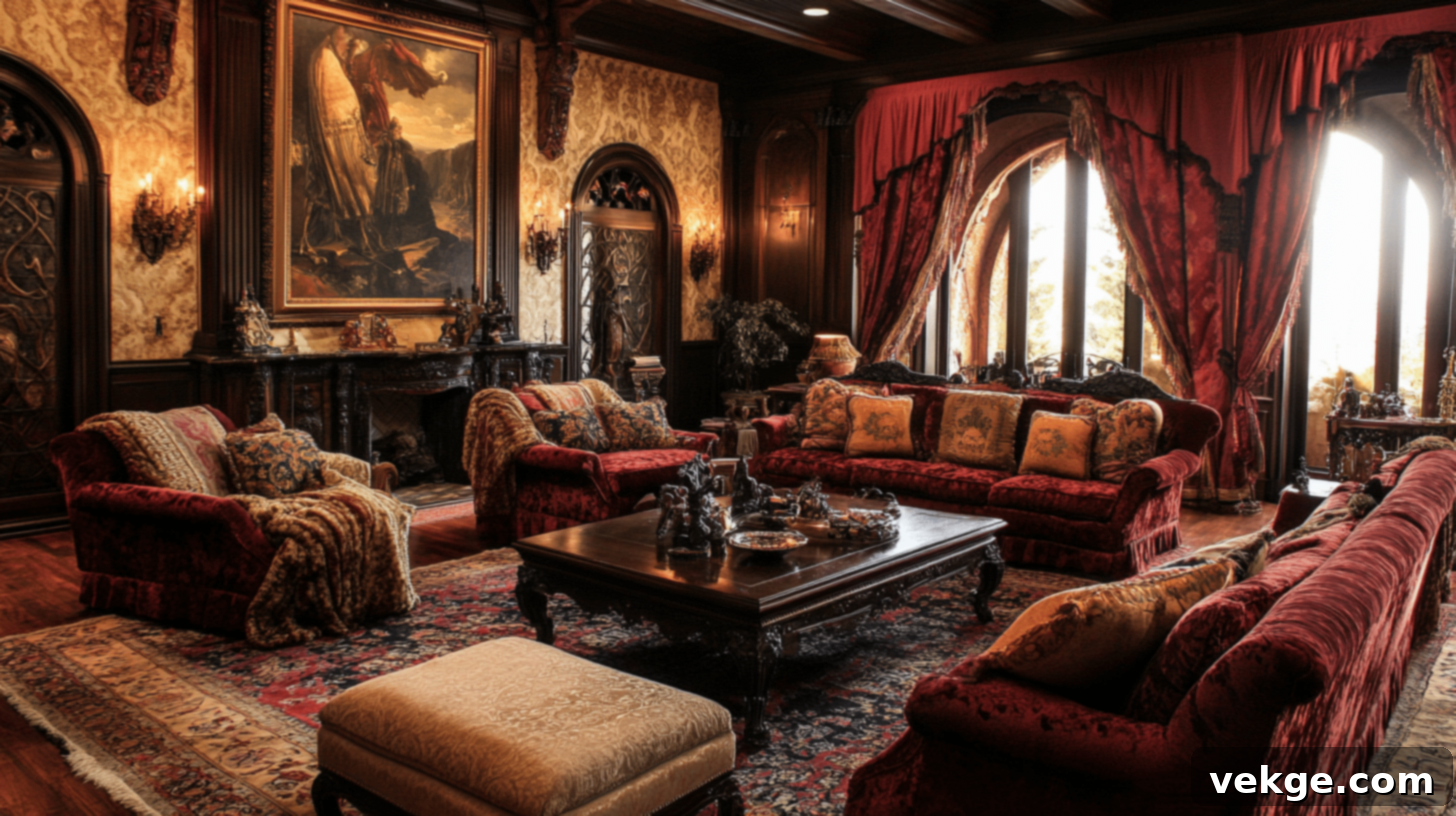
Gothic interior design places a significant emphasis on rich, tactile materials that engage all the senses, creating a multi-dimensional sensory experience. Velvet upholstery, with its deep pile and lustrous sheen, is a quintessential Gothic fabric. Adorning sofas, armchairs, and even headboards, velvet creates visual depth and captures light differently as one moves through a room, adding an unparalleled sense of opulence and comfort. Jacquard fabrics, with their complex woven patterns, introduce intricate visual complexity to curtains, throw pillows, and smaller accent pieces, often featuring botanical or heraldic motifs.
Ornate wall hangings, such as tapestries depicting historical scenes or natural landscapes, not only enhance the aesthetic but also significantly improve the acoustics of a room, adding warmth and absorbing sound. Thick, richly patterned rugs define distinct spaces within larger rooms and provide much-needed warmth and softness underfoot, especially when contrasted with cooler stone or dark wood floors. Heavy drapery, often in sumptuous fabrics like velvet or brocade, dramatically frames windows, offering both privacy and improved insulation. These carefully selected and layered textiles collectively create rooms that feel not only historically accurate and deeply luxurious but also profoundly comfortable and inviting, inviting touch and prolonged enjoyment.
Incorporating Gothic Design Elements into Your Home: A Practical Guide
Adopting Gothic design doesn’t require a medieval castle; with thoughtful application, you can imbue any contemporary home with this captivating aesthetic. Here’s how to strategically introduce Gothic elements.
Architectural Grandeur: Defining the Gothic Silhouette
You can infuse your home with Gothic architectural touches, even without undertaking extensive renovations. For doorways, consider adding arched molding or decorative spandrels above existing entrances to replicate the distinctive pointed arch effect, which is central to Gothic design. This relatively simple addition can transform plain rectangular openings into more dramatic and historically resonant focal points. In rooms with high ceilings, you can emphasize their verticality with dark paint on the ceiling or by adding faux ceiling beams, drawing the eye upward—a core Gothic principle that evokes grand cathedrals. For homes with standard ceiling heights, hanging tall, heavy curtains close to the ceiling line creates an illusion of greater height and a sense of theatricality.
Ornate woodwork, a hallmark of the style, doesn’t necessarily demand custom carpentry. Explore specialty home stores or architectural salvage yards for Gothic-inspired trim, corbels, or detailed wooden appliqués that can be added to plain doors, cabinet fronts, or fireplace mantels. Even simple wooden panels, arranged in geometric or vertical patterns on walls, can subtly suggest traditional Gothic wall treatments without the need for extensive remodeling, providing texture and historical depth.
Gothic Color Palette: Crafting Mood and Atmosphere
The careful selection of colors is paramount in immediately establishing a Gothic atmosphere. Deep emerald green, evocative of hidden forests and precious jewels, brings a natural richness and sophistication to dining rooms, studies, or libraries. Sapphire blue creates a tranquil yet dramatic ambiance in bedrooms and more formal living spaces, promoting a sense of calm and depth. Ruby red injects warmth and vitality into rooms that might otherwise feel cold or energy-starved, while amethyst purple offers an unexpected touch of luxury and mysticism, perfect for powder rooms or as an accent wall in a creative space. These intense colors are best balanced with softer neutral backgrounds—think warm grays, muted creams, or earthy taupes—which provide visual breathing room and allow architectural details and artwork to truly shine.
Metallic accents in brass, bronze, or copper are crucial for adding necessary light reflection, which is particularly important in Gothic interiors where general lighting is often kept low and moody. For lighting itself, focus on layered illumination. Combine dimmable overhead sources like a grand chandelier with strategic accent lights that highlight specific architectural features, artwork, or textural elements. Wall sconces placed at eye level create an intimate and inviting atmosphere essential to Gothic rooms, while the flickering glow of candles (real or flameless) adds an authentic, flattering light perfect for evening gatherings, further enhancing the dramatic mood.
Adding Gothic Motifs: Infusing Character and Story
Gothic-inspired furniture makes an immediate and powerful impact. Seek out pieces featuring classic Gothic details such as pointed arch cutouts, elegant quatrefoil designs, or distinctive spiral turnings. A magnificent carved wooden headboard can anchor a bedroom, a throne-like chair can serve as a striking accent in a living room, or a detailed buffet can become a focal point in a dining area. Ornate cornices above windows add architectural interest and historical accuracy, framing views with grandeur.
For the truly adventurous, small grotesque figures like gargoyles or mythical creatures can bring an authentic, whimsical, and deeply historical Gothic character to gardens, bookshelves, or fireplace mantels. Traditionally designed to ward off evil spirits, these creatures add distinctive personalities to modern spaces. The key to successfully integrating Gothic motifs is restraint and thoughtful curation. Choose one or two significant, impactful pieces rather than filling a room with an overwhelming array of competing ornate elements. This selective approach maintains a modern sensibility while honoring Gothic traditions. In contemporary homes, pairing these intricately detailed items with simpler, cleaner-lined modern pieces creates a crucial balance, ensuring livability and preventing the space from feeling like a period theme park. This thoughtful mixing of periods creates spaces with incredible depth, personality, and a timeless appeal, capturing the enduring magic of Gothic design in a fresh, inviting way.
How to Create a Moody Gothic Living Room: Drama and Comfort Combined
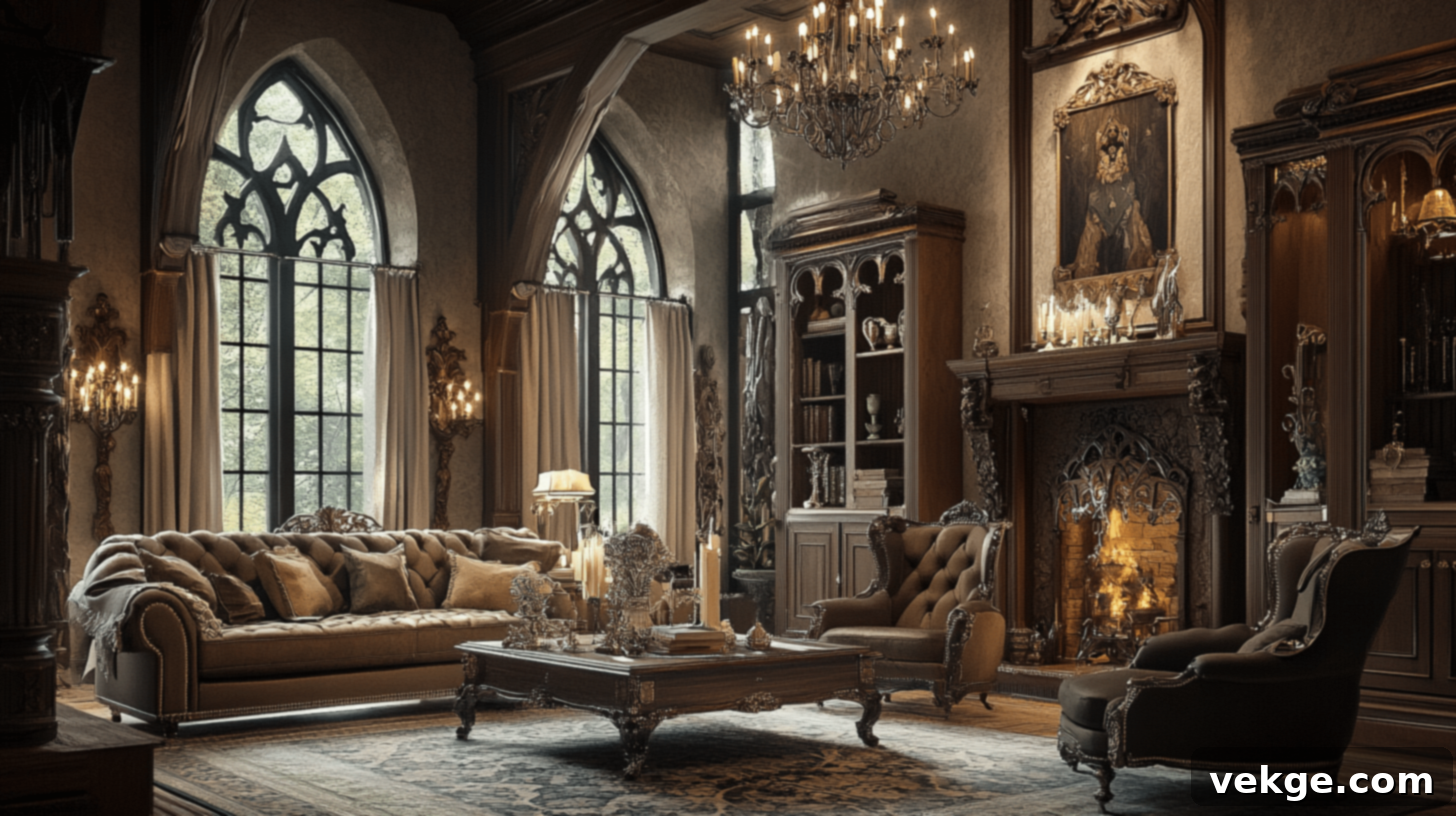
The living room is often the heart of the home, and transforming it into a moody Gothic sanctuary requires a deliberate approach to layout, lighting, and key features that invite both drama and comfort.
Strategic Room Layouts for Gothic Living
To cultivate a genuinely Gothic living room, consider arranging furniture with a natural, almost evolved feel, often leaning towards asymmetry rather than strict mirroring. Position a grand, deep-seated sofa as the central anchor, complemented by two different but equally substantial chairs that share similar heights. This approach maintains visual balance without the stiffness of perfect symmetry, creating a more organic and inviting arrangement. A majestic fireplace, ideally enhanced with dark, rough-hewn stone or intricately carved wood, should serve as the unequivocal central focus of the room. If a working fireplace isn’t present, a dramatic piece of artwork in a heavy, ornate frame or a large, gilded mirror can effectively substitute as a captivating focal point.
Lighting is paramount in defining the mood. Install an impressive iron or bronze chandelier as your primary overhead light source, equipping it with lower wattage, warm-toned bulbs to cast a soft, ambient glow rather than harsh illumination. Complement this with strategically placed wall sconces to highlight architectural details, artwork, or textured walls, while also providing practical task lighting for reading. Incorporate various table lamps with colored glass shades or rich fabric shades to add additional layers of warm, intimate light throughout the space. Finally, introduce varied wood tones through your furniture, flooring, and architectural elements like exposed ceiling beams or wall panels. This diversity in wood shades brings essential warmth and organic texture to the space, beautifully balancing the deeper, darker colors of the Gothic palette.
Feature Elements: The Soul of Your Gothic Living Room
Gothic motifs are the distinctive character builders for your living room. Seek out furniture pieces with exquisite carved details, such as elegant pointed arches, charming quatrefoils, or nature-inspired patterns like acanthus leaves or grapevines. It’s effective to include one truly standout piece with substantial carving—perhaps a throne-style chair upholstered in deep velvet, a meticulously detailed cabinet crafted from dark wood, or an ornate bookcase filled with ancient tomes. These pieces act as powerful statements, embodying the historical spirit of the style.
Opt for large, substantial furniture that feels grounded and luxurious, such as deep sofas with inviting tufted backs and hefty coffee tables that can proudly display decorative objects like candelabras or antique globes. The secret to a successful Gothic living room in a modern home lies in thoughtfully balancing these historical elements with contemporary touches for optimal livability. Discreetly hide modern technology within carved cabinets or behind screens. Update traditional furniture frames with current, luxurious fabrics in historical colors, and judiciously mix in some cleaner-lined modern items for a striking contrast. This thoughtful blend creates a Gothic space that feels genuinely authentic yet comfortable for daily use—atmospheric and dramatic without being stiff or museum-like, ultimately exuding a unique and welcoming character.
Creating a Gothic Bedroom: A Sanctuary of Peace and Drama

A Gothic bedroom can be a truly exceptional space, offering a unique blend of dramatic aesthetics and profound tranquility. Achieving this balance requires careful consideration of color, texture, and furniture arrangement.
Cultivating a Peaceful and Dramatic Ambiance
Through thoughtful color choices, a Gothic bedroom can masterfully balance its inherent drama with an overriding sense of serenity. Painting walls in deep navy blue, rich forest green, or sophisticated charcoal gray creates an immediately moody backdrop that feels both historically resonant and deeply restful, ideal for sleep and relaxation. These colors interact beautifully with both natural and artificial light, changing subtly throughout the day and night, adding dynamic depth to the room. To enhance the soothing atmosphere, consider painting the ceiling a slightly lighter shade of the wall color, or even a deep cream, to soften the intensity.
Quality materials are absolutely essential for bedding and window treatments, elevating the tactile experience of the Gothic bedroom. Choose pure linen sheets for their natural texture, breathability, and elegant drape, or opt for luxurious velvet duvets and pillows that catch the light exquisitely, adding an undeniable touch of opulence. Layering different fabrics is key to creating depth and visual interest on the bed. Imagine a plush wool throw draped over silken decorative pillows, or embroidered velvet cushions contrasting with a satin duvet. This interplay of textures makes the bed not just a place to sleep, but a grand focal point, rich in comfort and style.
Room Features: Defining Your Gothic Retreat
Arrange furniture symmetrically in the bedroom to cultivate a profound sense of order, balance, and calm, which is crucial for a restful space. Center your bed prominently on the main wall, flanked by identical nightstands and matching lamps on either side. Choose a substantial bed frame with a tall, imposing headboard, ideally featuring intricate carved details reminiscent of Gothic motifs, or plush tufted upholstery in a rich fabric like velvet or brocade. This creates an immediate sense of grandeur and a strong focal point.
Add a small, inviting reading corner with a comfortable, perhaps antique-style, armchair and a small side table positioned near a window. This dedicated nook creates a functional retreat within the bedroom, perfect for quiet contemplation or enjoying a book. A beautifully carved wooden bench or a storage ottoman placed at the foot of the bed offers not only a practical place to sit but also provides valuable extra storage for blankets or linens, enhancing both functionality and aesthetic appeal. Introduce dark, heavy curtains that effectively block out light, ensuring a deep and undisturbed sleep while adding to the room’s dramatic and enclosed feel.
Gothic Dining Room Ideas: Feasting in Grandeur
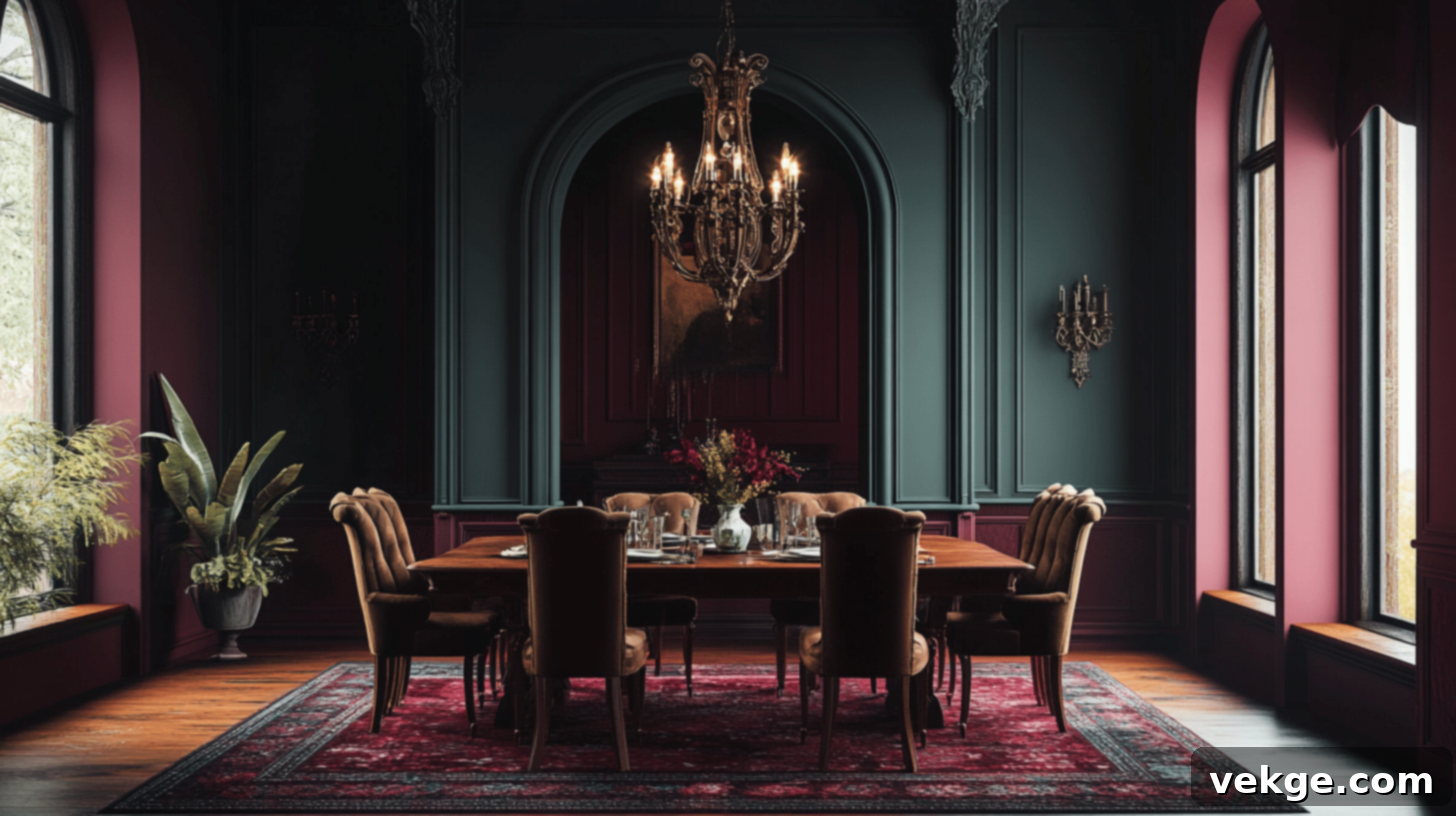
The dining room is a natural canvas for Gothic design, offering the perfect opportunity to create a space for lavish gatherings and dramatic meals. The interplay of rich colors, substantial furniture, and decorative accents can transform a simple meal into an unforgettable experience.
Crafting a Moody Dining Atmosphere
To create a truly captivating Gothic dining room, begin with rich wall colors that immediately set a dramatic and opulent tone. Deep burgundy, evocative of ancient tapestries and fine wines, adds warmth and passion. Navy blue provides profound depth and sophistication, while forest green offers a natural yet incredibly refined background. For maximum impact, consider painting all walls in one of these intense hues, or select one wall to serve as a dramatic accent, perhaps behind a buffet or a prominent piece of art. The ceiling can also be painted a slightly darker shade or adorned with decorative plasterwork to enhance the enclosed, intimate feel.
Position your dining table centrally within the room, ensuring it is the undisputed focal point. Above it, suspend a grand statement chandelier, ideally hanging 30-36 inches above the table surface to create an intimate pool of light for dining. Choose a substantial table with generous proportions and perhaps intricate carved details, such as a large solid oak or walnut piece. For a formal and balanced arrangement, select matching upholstered dining chairs with high backs, featuring subtle Gothic details like pointed arch cutouts, quatrefoil patterns, or tufting. These chairs should be comfortable enough for long, convivial meals, inviting guests to linger and enjoy the atmosphere.
Decorative Accents: The Finishing Touches of Gothic Elegance
Incorporate carved wood elements throughout the room to reinforce the authentic Gothic character. This can be seen in the intricate detailing of your dining table and chairs, but also in crown molding, wainscoting, or even decorative screens that subtly divide spaces. Look for historical details such as pointed arches, rosettes, or nature-inspired patterns like leaves and vines. These elements add layers of texture and narrative to the room. A glass-fronted display cabinet, often referred to as a curio cabinet or china cabinet, is an essential addition for showcasing fine dishware, crystal glassware, and antique treasures. Choose one with distinct Gothic architectural details—such as arched doors or carved pilasters—to ensure it becomes a captivating focal point even when closed.
Introduce metallic accents to reflect light and add sparkle. Silver candlesticks on the dining table, gold-rimmed plates during special occasions, or brass serving pieces can elevate the table setting. A large, ornate mirror with a heavily gilded or darkly carved frame can be strategically placed to reflect light and expand the sense of space, while also adding an element of historical grandeur. Metal wall sconces, perhaps in wrought iron or bronze, provide additional atmospheric lighting, casting a soft, romantic glow that perfectly complements the Gothic theme and enhances the overall ambiance of dramatic sophistication.
Combining Original Gothic Architecture with Modern Design: A Harmonious Blend
Honoring Original Features
When you have the privilege of working with authentic Gothic architecture, preservation becomes your guiding principle. Original vaulted ceilings, with their awe-inspiring height, complex structural ribbing, and often intricate bosses, create an unmatched visual impact. Rather than obscuring them, focus on carefully cleaning and highlighting these magnificent features, allowing their historical artistry to shine. Exposed stone walls, with their inherent texture and variations, tell a profound historical story; consider leaving sections visible to appreciate their raw beauty, while carefully insulating other areas for modern comfort and energy efficiency. Intricate woodwork, found in wall panels, ceiling beams, and detailed trim, deserves special attention. Gently clean these elements, repair any damage with historical accuracy in mind, and apply appropriate finishes that protect them without masking their character or patina.
Original stained glass windows cast a colored, ethereal light that no modern fixture can truly replicate. It’s vital to maintain these precious windows, perhaps adding discreet secondary glazing or storm windows for improved thermal efficiency and sound insulation without compromising their historical integrity. These cherished historic features truly gain new life and relevance when thoughtfully paired with contemporary furnishings. The key to this harmonious blend is balance—using simple, clean-lined modern pieces that complement rather than compete with the ornate, detailed historical features. This juxtaposition creates a dialogue between past and present, making the space feel both rooted in history and comfortably current.
Modern Updates for Contemporary Comfort
Living comfortably in historic Gothic spaces often requires the thoughtful integration of contemporary systems and conveniences. Update electrical wiring to safely support modern needs and technology, but ensure it is routed carefully to minimize any impact on original architectural features. Install discreet lighting solutions that not only provide sufficient brightness for everyday activities but also expertly highlight the unique architectural elements of the space. Consider recessed lighting that disappears into ceilings, or track lighting that can be precisely aimed.
Climate control can present unique challenges in historic buildings. Explore modern hydronic heating systems with minimal visual impact, or slim-profile radiators specifically designed for landmark spaces that blend seamlessly. Contemporary furniture can significantly improve comfort and functionality without sacrificing style. Look for pieces with clean, elegant silhouettes but crafted from luxurious materials that complement the richness of Gothic aesthetics, such as leather, dark wood, or velvet. Modern technology can be integrated subtly through hidden speakers, motorized window treatments that operate silently, and concealed televisions that retract into cabinets when not in use. Finally, energy efficiency improvements protect both your comfort and the building itself. Add insulation where feasible without damaging historic fabric, upgrade window treatments with thermal linings, and install smart home systems to manage lighting, heating, and cooling efficiently, ensuring your Gothic home is as sustainable as it is stunning.
Natural Textures in Gothic Interior Design: Bringing Nature Indoors
Gothic design, while often associated with drama and mystery, also embraces the natural world, drawing inspiration from the organic forms found in medieval cathedrals and illuminated manuscripts. Natural textures and patterns provide essential balance and softness to the powerful aesthetic.
Floral Patterns: Nature’s Intricate Artistry
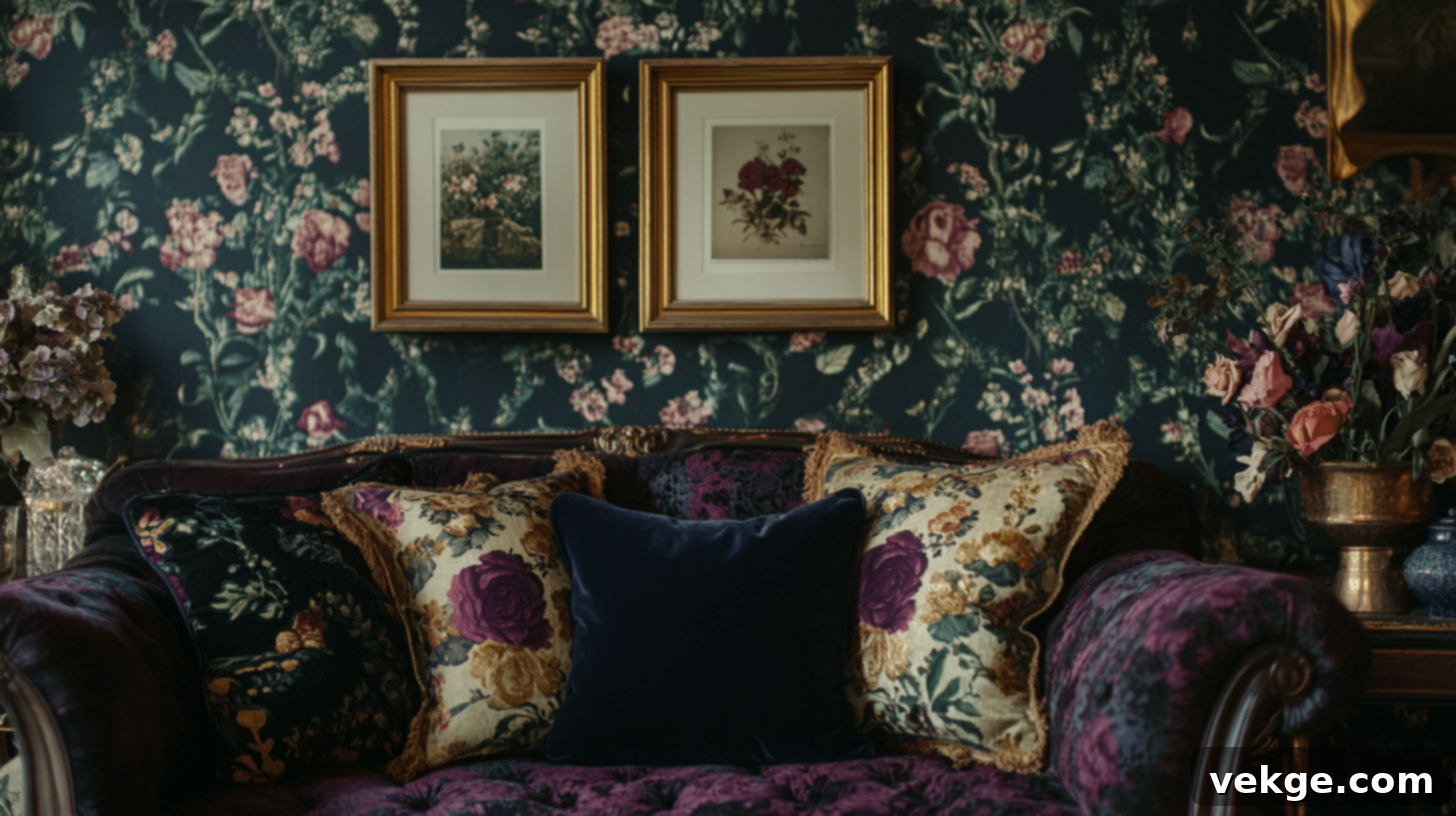
Floral patterns in Gothic interiors serve as a beautiful connection to the natural world, much in the same way that medieval cathedral stonework featured intricate botanical motifs and gargoyles depicted flora and fauna. Intricate floral wallpaper, often set against rich, moody colors, can add incredible depth and visual interest to walls. Imagine deep burgundy backgrounds adorned with subtle navy flowers, or forest green walls embellished with delicate golden botanical patterns—these combinations work particularly well, creating a sense of historical richness and natural elegance.
For a less permanent commitment, introduce floral throw pillows with detailed embroidery. Look for those featuring classic medieval flora such as roses (symbolizing love and purity), thistles (representing nobility), or oak leaves (denoting strength and endurance). These small accents can carry significant symbolic weight and textural appeal. Botanical prints, framed simply in dark wood or antique gold, can create captivating focal points, adding both scientific and natural interest to Gothic spaces. Group these prints symmetrically for formal areas or in more casual, artfully clustered arrangements in relaxed rooms. Finally, the inclusion of fresh flowers in dark pottery, antique silver, or metallic containers brings life, natural scent, and a touch of organic beauty to Gothic interiors, beautifully connecting these historically inspired spaces to the changing seasons and the vibrancy of the living world.
Natural Textiles: Comfort and Authenticity in Every Thread
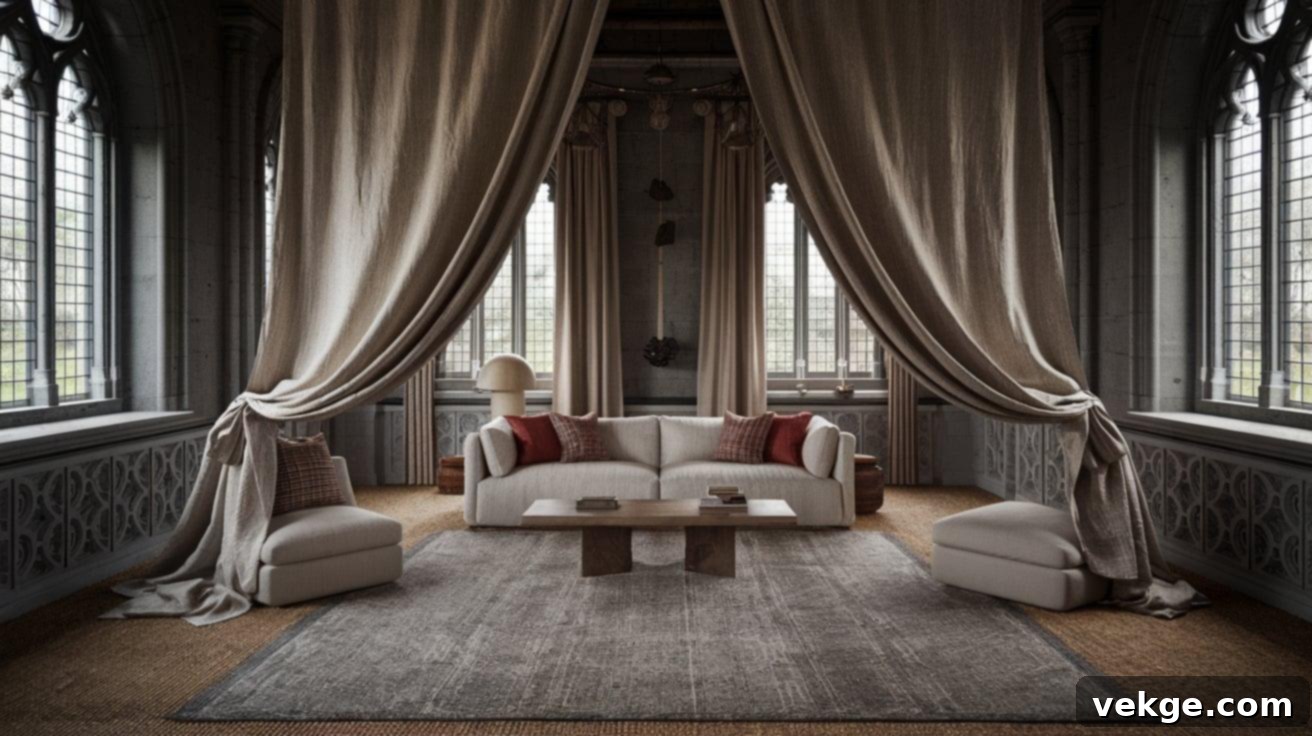
Natural fabrics are indispensable for adding warmth, authenticity, and profound comfort to Gothic design. Linen curtains, especially those with a heavier weight that pool slightly on the floor, create graceful lines and beautifully filter natural light, imparting a soft, diffused glow. Opt for heavier linen weights for the colder months to enhance insulation and a sense of coziness, and lighter, sheerer options for summer to maintain airiness while still providing privacy. Wool rugs, often featuring traditional or subtle geometric patterns, serve to anchor furniture groupings, add significant insulation, and improve sound absorption, making spaces feel quieter and more contained. Choose deep, muted colors with subtle patterns rather than bright, bold designs to maintain the sophisticated Gothic palette.
Cotton upholstery on seating offers a practical and comfortable choice for everyday use. Select tightly woven fabrics in solid, rich colors or small, intricate patterns that complement the overall scheme. For special, luxurious touches, incorporate raw silk on accent pillows or occasional chairs; this fabric possesses a unique ability to catch and reflect light differently from every angle, adding a dynamic sense of movement and visual interest to static spaces. In more casual or transitional areas, consider robust seagrass or jute floor coverings to provide a natural, earthy contrast to more formal elements, introducing textural variety and a rustic warmth. By layering different natural textiles throughout your space, mixing weights and finishes while maintaining a cohesive, rich color scheme, you can create a Gothic interior that feels both authentically historical and supremely comfortable, inviting lingering and relaxation.
Wood Accents: Grounding the Gothic Aesthetic
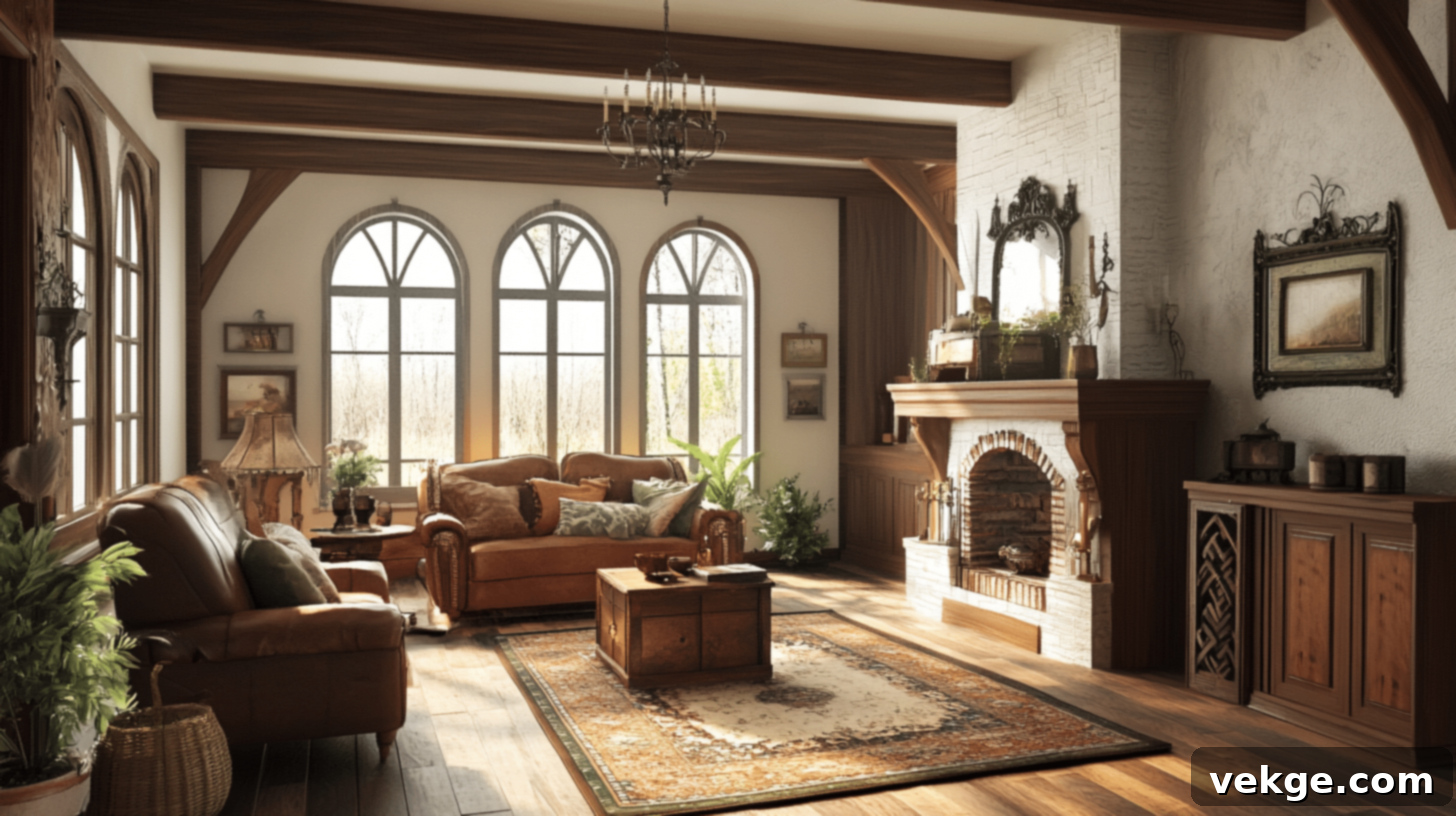
Wood elements are fundamental to grounding Gothic interiors in tradition and simultaneously bringing a natural, organic warmth to the dramatic aesthetic. Wide-plank hardwood floors in medium to dark tones provide the perfect foundational canvas. Materials like rich oak, elegant walnut, or reclaimed woods with visible grain and character align perfectly with Gothic sensibilities, speaking to durability and timeless beauty. If original hardwood floors are not an option, high-quality engineered wood or even luxury laminate flooring with convincing texture and appropriate tones can work exceptionally well, mimicking the natural appeal.
Exposed ceiling beams, whether structural components or artfully applied decorative additions, instantly add architectural interest and historical authenticity. In spaces with standard ceiling heights, consider adding false beams in key areas, such as over the main seating arrangement or running the length of the room, to create the same dramatic effect and draw the eye upwards. Carved wooden details are a hallmark of Gothic craftsmanship and can be incorporated on fireplace mantels, doors, and furniture pieces. Look for iconic motifs such as pointed arch carvings, elegant quatrefoils, or nature-inspired reliefs like grapevines and acanthus leaves, which lend an authentic, handcrafted character to any room. To avoid a monotonous look, strive to balance different wood tones rather than matching everything precisely. Mix darker, statement furniture pieces with medium-toned accents and perhaps lighter wood details on smaller decorative items. This variety creates a collected-over-time feeling that feels more authentic and lived-in than perfectly matched sets. Finally, wooden accessories like intricately carved boxes, substantial picture frames, and elegant candlesticks add the final touches of natural texture and historical charm throughout your Gothic-inspired space, completing the cohesive and rich aesthetic.
Tips for Decorating with Gothic Interior Design: Mastering the Art
Embracing Gothic interior design successfully involves a thoughtful blend of historical reverence and practical application. Here are some essential tips to guide your decorating journey:
Create Balance with Dark and Light
- While Gothic design is renowned for its rich, often dark color palettes, the most successful Gothic interiors master the art of incorporating strategic light touches to prevent the space from feeling overwhelmingly heavy or somber.
- Cultivate compelling contrast by pairing deep burgundy walls with crisp cream trim, introducing light silk pillows to a sumptuous navy sofa, or utilizing bright white marble on a fireplace against a dramatic forest green wall. This interplay adds dynamism and visual interest.
- Consider applying dark, intense colors on just one accent wall or in smaller, more intimate rooms, while keeping connecting spaces or larger areas in lighter, complementary neutral tones. This creates a journey through varying moods.
- Incorporating large mirrors with ornate frames and other reflective surfaces is crucial. These elements strategically bounce light throughout the room, making even deeply colored spaces feel more open, expansive, and inviting rather than enclosed or confined.
Utilize Chandeliers and Luxurious Lighting
- Lighting is arguably the most critical element in defining the mood and atmosphere within Gothic spaces. A grand wrought iron chandelier creates an instant, powerful Gothic focal point in formal dining rooms, majestic entryways, or even expansive living areas, exuding an antique charm.
- For added historical accuracy and a touch of dazzling brilliance, consider crystal chandeliers adorned with candle-style bulbs. These fixtures merge old-world elegance with captivating sparkle.
- Wall sconces placed at eye level offer both practical task lighting for intimate moments and contribute to the overall atmospheric glow, casting soft pools of light.
- Seek out lighting fixtures that incorporate subtle Gothic motifs, such as pointed arches, quatrefoils, or stylized floral details, to reinforce the theme.
- Elevate the sense of luxury through metallic finishes—brass fixtures impart a warm, inviting glow, while silver or polished chrome brings a cool, sophisticated brilliance. Crystal elements within fixtures are especially effective, catching and reflecting light in mesmerizing ways, adding movement and a sense of enchantment to Gothic rooms.
Wrapping Up: Embracing the Enduring Appeal of Gothic Design
Gothic interior design continues to captivate and appeal across centuries because of its unique ability to combine profound drama, rich history, and surprising comfort in ways few other styles can match. By thoughtfully focusing on its key elements—a deep, moody color palette, the iconic elegance of pointed arches, the intricate beauty of carved details, and the inviting richness of layered textures—you can create spaces within your home that possess genuine character and leave a lasting, impactful impression.
The most successful Gothic interiors are those that master the delicate art of balance: balancing areas of darkness with strategic touches of light, seamlessly integrating historical elements with modern functionality, and juxtaposing dramatic statements with practical comfort for daily living. This thoughtful and nuanced approach ensures that your Gothic-inspired home remains both visually striking and thoroughly livable—a unique sanctuary where the grandeur of history and the conveniences of the present day meet in perfect, harmonious alliance. It’s a style that invites exploration, storytelling, and an unparalleled sense of atmosphere.
If your curiosity for distinctive decor styles extends beyond the captivating world of Gothic design, we invite you to explore other fascinating themes and inspirations by navigating through our comprehensive website.
